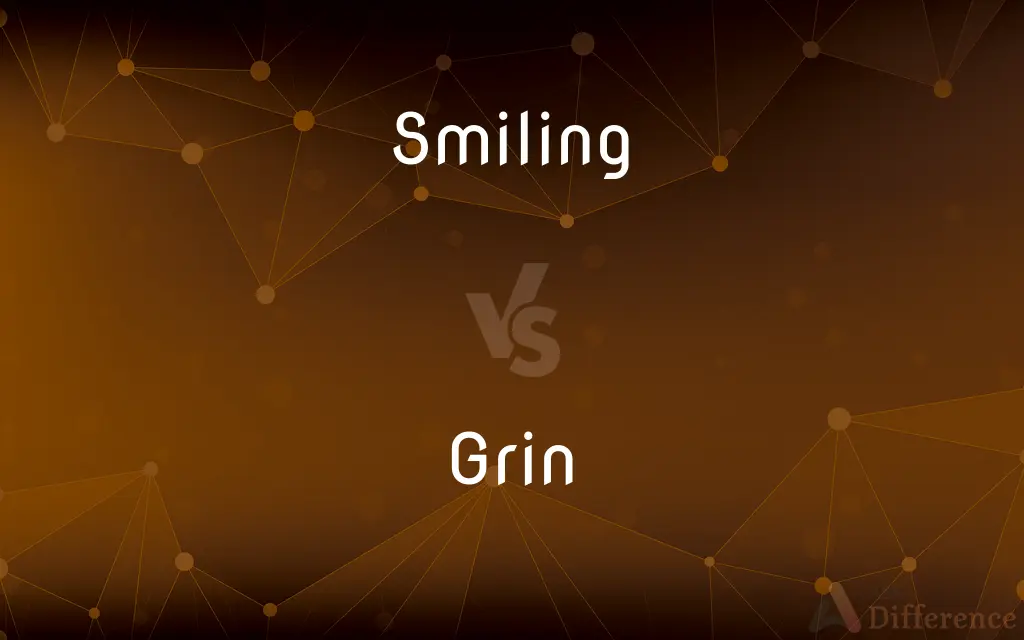Smiling vs. Grin — What's the Difference?
By Fiza Rafique & Urooj Arif — Updated on March 25, 2024
Smiling is a gentle, broad expression showing pleasure or happiness, often engaging the eyes, while a grin is a wide smile without eye participation, sometimes implying amusement or sarcasm.

Difference Between Smiling and Grin
Table of Contents
ADVERTISEMENT
Key Differences
Smiling is a universal expression of happiness, friendliness, or pleasure, typically involving both the mouth and eyes, signaling genuine emotion or social bonding. In contrast, grinning is characterized by a wide, often toothy smile that doesn't necessarily reach the eyes, and can indicate amusement, self-satisfaction, or sometimes sarcasm.
The act of smiling can be both voluntary and involuntary, reflecting a natural response to positive emotions or a social gesture to convey politeness and warmth. On the other hand, grins, while they can be spontaneous, often carry a specific intention or reaction, such as amusement at a joke, and might not always be associated with true happiness.
Smiling is a powerful tool in social interactions, capable of fostering trust and cooperation, and is often encouraged in social and professional settings to build rapport. Grinning, however, due to its varied implications, can sometimes be misinterpreted, especially if the context isn't clear or if it's perceived as insincere or mocking.
In terms of facial muscle involvement, smiling primarily uses the zygomaticus major muscles to lift the corners of the mouth, and can also engage the orbicularis oculi muscles around the eyes in genuine smiles. Grins primarily involve the muscles that stretch the mouth horizontally and may not engage the muscles around the eyes as much, leading to a smile that can appear less warm or engaging.
Culturally, smiling is almost universally seen as a positive expression, while the interpretation of grinning can vary significantly, with nuances that can depend on the situation, the relationship between the people involved, and cultural norms regarding expressiveness and emotional display.
ADVERTISEMENT
Comparison Chart
Definition
An expression of happiness, warmth, or politeness involving mouth and often eyes
A wide, often toothy smile, typically not involving the eyes
Emotional Association
Genuine happiness, friendliness, pleasure
Amusement, self-satisfaction, sometimes sarcasm
Involvement of Eyes
Often involves smiling with the eyes ("Duchenne smile")
Rarely involves the eyes; mostly just the mouth
Social Implication
Builds trust and cooperation, universally positive
Can be positive or negative, depending on context
Muscle Use
Zygomaticus major, sometimes orbicularis oculi
Primarily muscles that stretch the mouth horizontally
Compare with Definitions
Smiling
A smile is a facial expression formed by flexing the muscles near both ends of the mouth, often genuinely expressing happiness.
She greeted her friend with a warm, welcoming smile.
Grin
A grin is a broad smile without the involvement of the eyes, often signaling amusement or mischief.
He wore a mischievous grin after playing the prank.
Smiling
Smiling is often involuntary, reflecting an instinctive response to positive emotions or interactions.
The surprise gift made her smile instinctively with joy.
Grin
Grinning can indicate a range of emotions from amusement to competitive spirit.
The athlete grinned confidently as he crossed the finish line.
Smiling
Smiling can serve as a social signal of goodwill or politeness in various cultural contexts.
During the interview, he maintained a polite smile to convey friendliness.
Grin
In literature and media, grinning characters are often portrayed as cheeky, cunning, or possessing secret knowledge.
The character's constant grinning gave him an air of mystery and intrigue.
Smiling
Genuine smiles, involving the eyes, are known as Duchenne smiles and are signs of true happiness.
Her eyes crinkled with a genuine Duchenne smile as she laughed.
Grin
Unlike smiles, grins may not always convey friendliness and can sometimes be interpreted as sarcasm.
Her grin seemed more sarcastic than genuinely amused.
Smiling
In social interactions, smiling can enhance one's likability and approachability.
Her constant smiling made her seem more approachable at the party.
Grin
A grin is often a deliberate expression, chosen to convey a specific message or emotion.
With a knowing grin, she hinted at the surprise she had planned.
Smiling
A facial expression characterized by an upward curving of the corners of the mouth and indicating pleasure, amusement, or derision.
Grin
Smile broadly
Dennis appeared, grinning cheerfully
Smiling
To have or form a smile.
Grin
A broad smile
A silly grin
Smiling
To look with favor or approval
Fortune smiled on our efforts.
Grin
To smile broadly, often baring the teeth, as in amusement, glee, embarrassment, or other strong emotion.
Smiling
To express cheerful acceptance or equanimity
We smiled at the bad weather and kept going.
Grin
To express with a grin
I grinned my approval.
Smiling
To express with a smile
Grandmother smiled her consent.
Grin
The act of grinning.
Smiling
That smiles or has a smile.
Smiling children
Grin
The facial expression produced by grinning.
Smiling
The action of the verb to smile.
Smiling takes fewer muscles than frowning.
Grin
A smile in which the lips are parted to reveal the teeth.
Smiling
Present participle of smile
They were smiling at the children.
Grin
(obsolete) A snare; a gin.
Smiling
A facial expression characterized by turning up the corners of the mouth; usually shows pleasure or amusement
Grin
(intransitive) To smile, parting the lips so as to show the teeth.
Why do you grin?
Did I say something funny?
Smiling
Smiling with happiness or optimism;
Come to my arms, my beamish boy!
A room of smiling faces
A round red twinkly Santa Claus
Grin
(transitive) To express by grinning.
She grinned pleasure at his embarrassment.
Grin
To show the teeth, like a snarling dog.
Grin
(transitive) To grin as part of producing a particular facial expression, such as a smile or sneer.
He grinned a broad smile when I told him the result.
He grinned a cruel sneer when I begged him to stop.
Grin
A snare; a gin.
Like a bird that hasteth to his grin.
Grin
The act of closing the teeth and showing them, or of withdrawing the lips and showing the teeth; a hard, forced, or sneering smile.
He showed twenty teeth at a grin.
Grin
To show the teeth, as a dog; to snarl.
Grin
To express by grinning.
Grinned horrible a ghastly smile.
Grin
A facial expression characterized by turning up the corners of the mouth; usually shows pleasure or amusement
Grin
To draw back the lips and reveal the teeth, in a smile, grimace, or snarl
Common Curiosities
What is the main difference between a smile and a grin?
The main difference lies in the involvement of the eyes and the breadth of the mouth's movement; smiles are warm and can involve the eyes, while grins are wider and generally do not involve the eyes.
Is it possible to distinguish a genuine smile from a forced one?
Yes, genuine smiles, or Duchenne smiles, involve the eyes and create crow's feet, whereas forced smiles primarily involve just the mouth.
How do cultural differences affect the perception of smiling and grinning?
Cultural norms significantly influence how expressions are interpreted; in some cultures, excessive smiling or grinning may be seen as insincere or inappropriate.
Why do people grin?
People may grin for various reasons, including amusement, satisfaction, nervousness, or as a social cue to signal a non-serious or playful intent.
Is grinning always intentional?
While grinning can be involuntary in response to certain stimuli, it is often used intentionally to convey specific emotions or reactions.
Do animals smile or grin?
Some animals may appear to smile or grin, but these expressions may not carry the same emotional or social connotations as they do for humans.
Can grinning be considered rude?
In some contexts, grinning can be perceived as rude or mocking, especially if it's seen as insincere or inappropriate for the situation.
How does smiling affect social interactions?
Smiling can make individuals appear more likable, trustworthy, and approachable, facilitating positive social interactions.
What role does grinning play in communication?
Grinning can add nuance to communication, signaling anything from light-heartedness to sarcasm, significantly depending on context and delivery.
Can smiling have psychological benefits?
Yes, smiling can release endorphins, reducing stress and improving overall mood, even if the smile is forced or not genuinely felt at the moment.
Share Your Discovery

Previous Comparison
Parameterised vs. Parameterized
Next Comparison
Variable vs. VariantAuthor Spotlight
Written by
Fiza RafiqueFiza Rafique is a skilled content writer at AskDifference.com, where she meticulously refines and enhances written pieces. Drawing from her vast editorial expertise, Fiza ensures clarity, accuracy, and precision in every article. Passionate about language, she continually seeks to elevate the quality of content for readers worldwide.
Co-written by
Urooj ArifUrooj is a skilled content writer at Ask Difference, known for her exceptional ability to simplify complex topics into engaging and informative content. With a passion for research and a flair for clear, concise writing, she consistently delivers articles that resonate with our diverse audience.














































